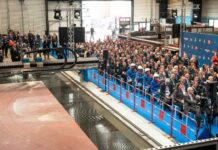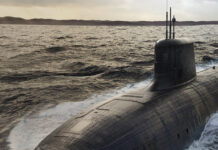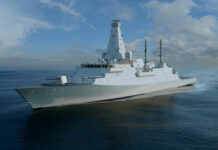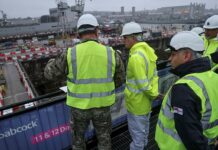The UK Ministry of Defence (MoD) published its Defence Nuclear Command Paper on 25 March 2024. Titled ‘Delivering the UK’s Nuclear Deterrent as a National Endeavour’, the paper sets out the country-wide strategy that will see the UK’s Continuous-At-Sea Deterrent (CASD), delivered by the Royal Navy’s Operation ‘Relentless’ since April 1969, maintained and renewed.
More expansively, the 40-page document details the many areas of focus that will be required as the UK continues to operate its fleet of nuclear-powered ballistic missile submarines (SSBNs) and nuclear-powered attack submarines (SSNs) for several decades to come.
Firstly, the paper resolves that the UK government will “sustain the UK’s nuclear deterrent for as long as it is required”. This involves maintaining the current in-service fleet of Vanguard-class SSBNs while progressing with the new Dreadnought-class SSBNs for entry into service in the early 2030s.
The paper additionally notes that the UK parliament committed to replacing its sovereign nuclear warhead in February 2021. “The Replacement Warhead Programme has been designated the A21/Mk7 (also known as Astraea). It is being delivered in parallel with the US W93/Mk7 warhead and each nation is developing a sovereign design,” the paper explains. “This will be the first UK warhead developed in an era where we no longer test our weapons underground, upholding our voluntary moratorium on nuclear weapon test explosions. This is possible because of the long history of technical expertise and extensive investment in UK modelling and simulation, supercomputing, materials science, shock and laser physics at AWE [the UK’s Atomic Weapon Establishment].”
While the paper adds that “we remain committed to the ultimate goal of a world without nuclear weapons and support full implementation of the Treaty on the Non-Proliferation of Nuclear Weapons (NPT)”, forewords from UK Prime Minister Rishi Sunak and Defence Secretary Grant Shapps make clear that, amid the current military-geopolitical climate of Russia’s invasion of Ukraine and other threats to the international rules-based order, no prospects for nuclear disarmament can currently be contemplated.
“Against this uncertain global security outlook,” wrote Sunak, “the foundational component of an integrated approach to deterrence and defence remains a credible, independent UK nuclear deterrent, declared to the defence of NATO.”
The paper also notes that the UK government will sustain the UK’s current fleet of Astute-class SSNs while designing the next-generation SSN-AUKUS fleet through a “deep collaboration with our US and Australian partners under the ground-breaking AUKUS trilateral partnership”.
“The AUKUS partnership is one of the most strategically important capability collaborations in decades,” the paper states. “For all three countries, it will help meet our shared commitment to supporting stability and security through a free and open Indo-Pacific by progressing towards more unified defence and industrial collaboration, better information and technology sharing, and greater resilience, helping develop joint capabilities.”
The Defence Nuclear Command Paper additionally notes the work that will have to be done around the UK in the areas of recruitment and infrastructure development. The UK government, it says, will “recruit the skills of the future – with a clear plan to expand the nuclear workforce to meet our ambitions in this growing sector and develop targeted interventions to ensure we have the specialist skills required now and in future through a new nuclear skills plan”.
The government will also “renew and upgrade key infrastructure and naval bases – with an additional GBP 3 billion (EUR 3.5 billion) invested across the Defence Nuclear Enterprise to 2024/25, supporting areas such as the construction of industrial infrastructure at Barrow, Derby and at the Atomic Weapons Establishment, as well as at His Majesty’s Naval Bases”, the paper says.
Among other areas of focus highlighted by the paper is the future work that will be done to further develop naval nuclear reactor technology to power the UK’s future submarines.
“The development of a future generation of nuclear propulsion systems available to power UK submarines beyond SSN-AUKUS has commenced,” the paper noted. ‘Nuclear Propulsion Plant – X’ will span several decades, providing further opportunity across industry and academia. Its primary aim is to produce a step change in reactor plant design, specifically in terms of performance.”













